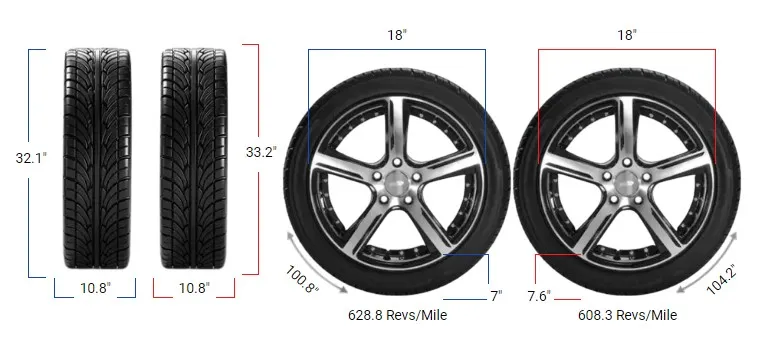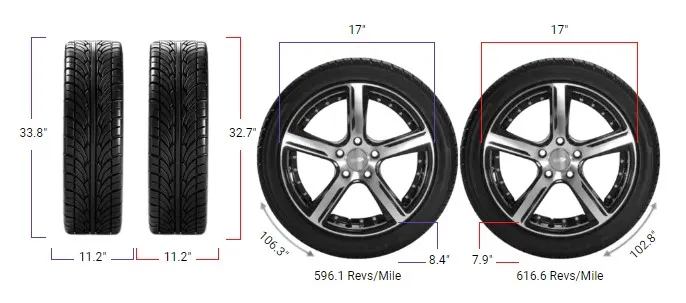Tire Size 215/65r17 vs 225/65r17

Thinking about switching from 215/65R17 to 225/65R17 tires? Let’s break down what this change means and how it could affect your driving experience, both on and off the road.
- The wider 225/65R17 tire offers better road grip and stability.
- Slight increase in ground clearance provides marginal off-road benefits.
- Slightly reduced fuel efficiency due to increased rolling resistance.
- The taller sidewall improves ride comfort on rough or uneven roads.
- Speedometer reading will be slightly slower than your actual speed.

Fitment Guide
The diameter difference between 215/65R17 and 225/65R17 is 1.8%, which falls within the acceptable range.
This means the switch won’t cause any major issues in terms of tire fitment, but you should still be mindful of any necessary adaptations to avoid rubbing or clearance issues.
If you notice any rubbing after switching, modifications to your vehicle may be required.
On-Road Impact
Switching from 215/65R17 to 225/65R17 has several on-road implications, such as changes in ground clearance, speedometer accuracy, and ride comfort.
While the difference in tire dimensions is minor, it can still impact fuel efficiency and handling. Here’s a breakdown of the main factors you might experience during on-road driving:
- Ground Clearance: The 225/65R17 tire has a slightly larger diameter, increasing ground clearance by 0.26 inches. This difference is subtle but can provide a marginal benefit when driving over bumps or uneven roads.
- Gas Mileage: A wider tire typically increases rolling resistance, which can lead to a minor drop in fuel efficiency. With the 225/65R17, expect a small reduction in gas mileage, though it’s unlikely to be significant enough to outweigh the performance benefits.
- Aesthetics: Wider tires give a more aggressive look, which some drivers prefer for both style and perceived toughness. The 225/65R17 adds a bit more bulk to the vehicle’s stance, enhancing its visual appeal, especially for SUVs.
- Ride Comfort: The slightly taller sidewall of the 225/65R17 tires can improve ride comfort by offering more cushioning when driving over uneven surfaces. However, the difference in sidewall height is only 0.26 inches, so the improvement in comfort is marginal.
- Speedometer Accuracy: The speedometer will read about 1.8% slower than your actual speed with the new tire size. For example, when the speedometer shows 20 mph, you’ll actually be traveling at 20.37 mph. While this is a small deviation, it’s important to keep in mind for speed-sensitive areas like school zones or highways.
- Durability & Wear: A wider tire typically has a more even wear pattern, which may enhance the tire’s lifespan depending on driving conditions. However, the difference here is minor, and other factors such as road surface and driving habits will still play a larger role in wear.
Off-Road Impact
For those who enjoy off-road driving, switching to a 225/65R17 tire can provide some tangible benefits.
Off-road conditions often demand more from tires in terms of durability, traction, and performance. Here’s how the change affects off-road driving:
- Ground Clearance: As mentioned earlier, the 225/65R17 gives an additional 0.26 inches of ground clearance. While this might seem minimal, in off-road conditions where every bit of clearance can help, this added height could provide a slight edge when navigating rocky terrain or obstacles.
- Traction: A wider tire generally offers better traction, especially on loose surfaces like dirt, gravel, or mud. The 10 mm increase in width can help improve grip, making the 225/65R17 a more reliable choice for off-road driving.
- Handling and Stability: Wider tires often result in better stability, which is especially beneficial in off-road conditions. The 225/65R17 will offer a slight improvement in vehicle control and handling on uneven or slippery surfaces, thanks to the increased contact patch.
- Ride Comfort: Just as on-road, the larger sidewall in the 225/65R17 provides a bit more cushion, improving comfort when tackling rugged terrain. However, since the difference in sidewall height is small, the effect on comfort will be subtle.
- Durability: Off-road conditions can accelerate tire wear, but the 225/65R17’s increased width can help distribute the load more evenly, potentially extending the tire’s life under rough conditions.
215/65r17 vs 225/65r17
| Feature | 215/65R17 | 225/65R17 | Difference |
|---|---|---|---|
| Diameter inches (mm) | 28 (711.3) | 28.52 (724.3) | +0.51 (+13) +1.8% |
| Width inches (mm) | 8.46 (215) | 8.86 (225) | +0.39 (+10) +4.7% |
| Circumference inches (mm) | 87.98 (2234.61) | 89.58 (2275.46) | +1.61 (+40.84) +1.8% |
| Sidewall Height inches (mm) | 5.5 (139.75) | 5.76 (146.25) | +0.26 (+6.5) +4.7% |
| Revolutions per mile (km) | 720.19 (447.5) | 707.26 (439.47) | -12.93 (-8.03) -1.8% |
| Speedo Reading | 20 mph (32.19 km/h) | 20.37 mph (32.78 km/h) | +0.37 mph (+0.59 km/h) |
Difference Between 215/65r17 and 225/65r17
The main difference between 215/65R17 and 225/65R17 tires is their width. The 225/65R17 tire is wider by 10 mm, providing better road grip and handling.
Can I Use 225/65r17 Instead of 215/65r17?
Yes, you can use 225/65R17 instead of 215/65R17. The diameter difference is within 3%, making the switch safe without significant impact on performance.
How Much Taller Is a 225/65r17 Tire Than a 215/65r17?
The 225/65R17 tire is 0.51 inches (13 mm) taller than the 215/65R17 tire, which slightly improves ground clearance.
How Much Wider Is a 225/65r17 Tire Than a 215/65r17?
The 225/65R17 tire is 0.39 inches (10 mm) wider than the 215/65R17, which can enhance stability and traction, especially on uneven surfaces.
Our Observation
Switching from 215/65R17 to 225/65R17 brings both benefits and minor shortcomings. On the road, the wider 225/65R17 offers better grip and a more aggressive appearance, with slightly improved handling and stability.
The ride comfort is also marginally better due to the taller sidewall, and the increase in ground clearance, while small, could prove useful on uneven roads.
However, you may experience a small reduction in fuel efficiency due to the increased rolling resistance, and your speedometer will read slightly lower than your actual speed.
Off-road, the wider tires provide improved traction and stability, which can be a real advantage in rugged terrains. Despite these benefits, the differences are generally subtle and may be negligible in certain driving conditions, especially if you primarily stick to paved roads.



